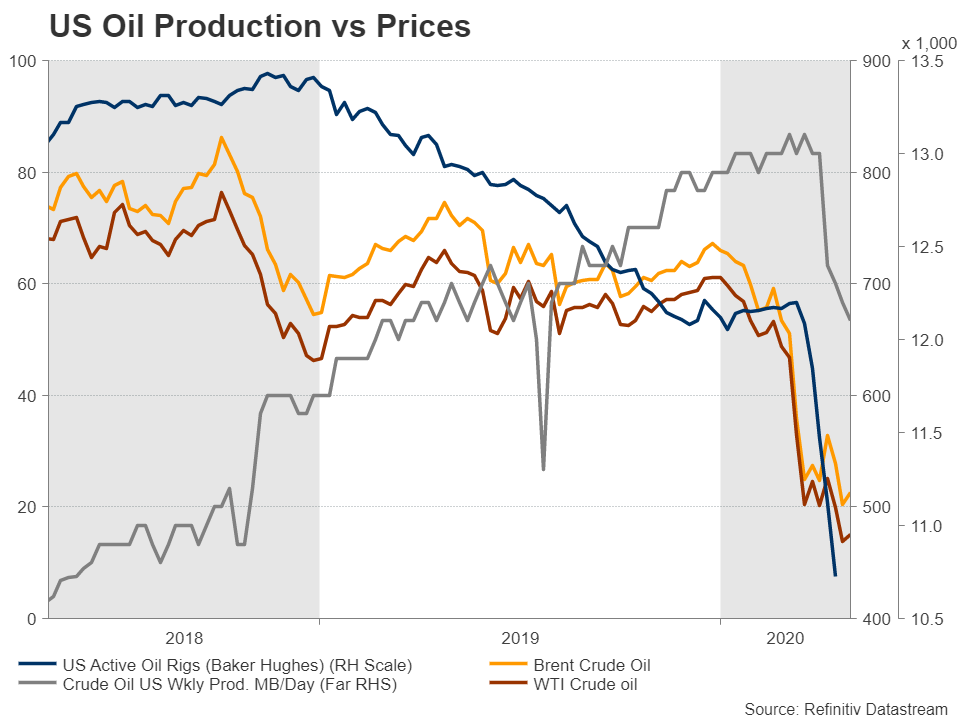Virus to slam Exxon Mobil and Chevron revenue but EPS to stay positive – Stock Market News
Exxon – the world’s fifth largest company by revenue – is expected to see its Q1 revenue plummet by 30.4% on an annual basis to $44.3 billion as weaker oil prices likely hurt the company’s income from upstream operations. It’s worth being reminded that the slide in oil had started in early January before accelerating in March when the virus crisis erupted, so the impact of lower prices would have been felt across the entire quarter.
Earnings per share (EPS) is forecast to take an even bigger tumble, dropping a whopping 93.7% year-on-year to 3 cents according to Refinitiv I/B/E/S estimates. That would just keep it in positive territory, but not for long. EPS is anticipated to turn sharply negative (-63 cents) in the second quarter and not return to profit until the second quarter of 2021.

The outlook for Chevron’s earnings is equally gloomy. The company’s revenue is estimated to have plunged by 17.6% y/y to $29.0 billion in Q1, while EPS is forecast to have fallen 51.1% to 68 cents. The decline in earnings is expected to worsen in the coming quarters with EPS hitting a loss of 95 cents in Q2.
Outlook uncertainWhether the estimates for the second quarter get revised higher or lower will not only depend on the companies’ own guidance but how the COVID-19 pandemic unfolds in the coming weeks and months. The freefall in oil prices has pushed many smaller energy firms to the brink of collapse. The fate of bigger companies is also uncertain as the bailout fund included in the US government’s near $3 trillion virus stimulus does not cover the oil and gas sector. The Trump administration is struggling to get Congress to approve funds for energy companies.
With some US states beginning to ease social distancing measures, allowing some businesses to reopen, it’s easy to assume the worst is over. But even if demand for fuel begins to pick up as the lockdowns are gradually lifted, there is little prospect of US and global oil consumption recovering to the levels it was prior to the outbreak of the coronavirus.
Dividends safe as capex slashedThis puts the focus on what measures oil and gas firms can take themselves to ride out the virus storm. The easy option is to cut capital expenditure and freeze costly projects. Chevron has already slashed $4 billion in capital spending, while Exxon expects to reduce its investments in 2020 by 30%. The other obvious target for cuts is dividends. However, this is likely to be a controversial decision for oil CEOs as big multinational oil firms have a proud record of being consistent with their dividend payouts and past behaviour shows they prefer to raise cash through borrowing to maintain their dividends.
In fact, Exxon successfully borrowed $18 billion in March and April by issuing corporate bonds. With the Fed committed to supporting the markets and preserving credit flows to businesses, energy giants will probably have no trouble tapping into debt markets. And investors do not appear to be worried either when looking at the share price performance.
Oil stocks not excluded from equities reboundExxon’s stock has rallied by almost 50% from the trough plumbed in March at the height of the virus turmoil. Chevron has done even better, with its stock rebounding by more than 80%. Year-to-date, the virus damage is more evident with Exxon still down about 32% and Chevron 21.5%. Amazingly, both Exxon and Chevron have maintained their mean recommendations of ‘hold’ and ‘buy’ respectively, despite oil being one of the hardest hit industries from the pandemic.

Looking at their price/earnings (PE) ratios, it’s difficult to see a particular attraction. Exxon has a PE ratio of 14.12, above its sector average of 9.86, though it’s below that of the S&P 500 (26.08). Chevron’s PE is even less attractive at 58.21, which is much higher than the average of its peers of 15.30.
All hopes on market rebalancingWhether the recovery in their share price proves sustainable will probably depend on the extent to which oil production declines in the coming months. With the chances of another OPEC-led cut being remote, the sector’s best hope is for the market to adjust itself and that’s likely to come at the expense of US shale producers.
 American shale firms were already feeling the pressure from weaker oil prices and the virus impact has only deepened the slump. The number of active oil rigs stood at just 378 in the week ending April 24, down from 670 at the start of 2020. If that trend continues and the demand outlook starts to brighten as more economies reopen, there will be a strong case for a rebound in oil prices from the current historical lows.
American shale firms were already feeling the pressure from weaker oil prices and the virus impact has only deepened the slump. The number of active oil rigs stood at just 378 in the week ending April 24, down from 670 at the start of 2020. If that trend continues and the demand outlook starts to brighten as more economies reopen, there will be a strong case for a rebound in oil prices from the current historical lows.免責聲明: XM Group提供線上交易平台的登入和執行服務,允許個人查看和/或使用網站所提供的內容,但不進行任何更改或擴展其服務和訪問權限,並受以下條款與條例約束:(i)條款與條例;(ii)風險提示;(iii)完全免責聲明。網站內部所提供的所有資訊,僅限於一般資訊用途。請注意,我們所有的線上交易平台內容並不構成,也不被視為進入金融市場交易的邀約或邀請 。金融市場交易會對您的投資帶來重大風險。
所有缐上交易平台所發佈的資料,僅適用於教育/資訊類用途,不包含也不應被視爲適用於金融、投資稅或交易相關諮詢和建議,或是交易價格紀錄,或是任何金融商品或非應邀途徑的金融相關優惠的交易邀約或邀請。
本網站的所有XM和第三方所提供的内容,包括意見、新聞、研究、分析、價格其他資訊和第三方網站鏈接,皆爲‘按原狀’,並作爲一般市場評論所提供,而非投資建議。請理解和接受,所有被歸類為投資研究範圍的相關内容,並非爲了促進投資研究獨立性,而根據法律要求所編寫,而是被視爲符合營銷傳播相關法律與法規所編寫的内容。請確保您已詳讀並完全理解我們的非獨立投資研究提示和風險提示資訊,相關詳情請點擊 這裡查看。
